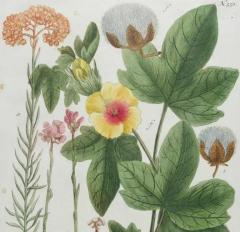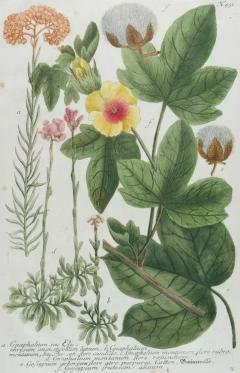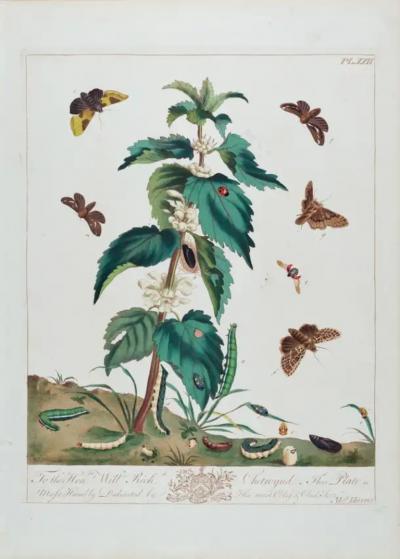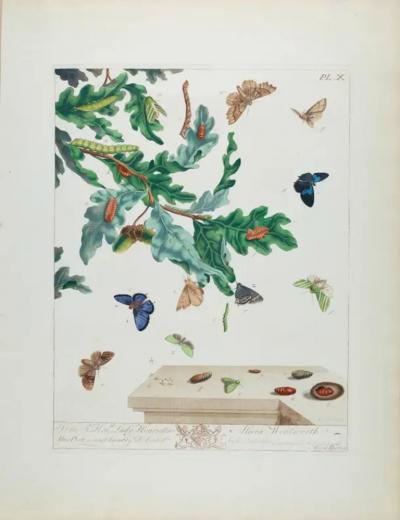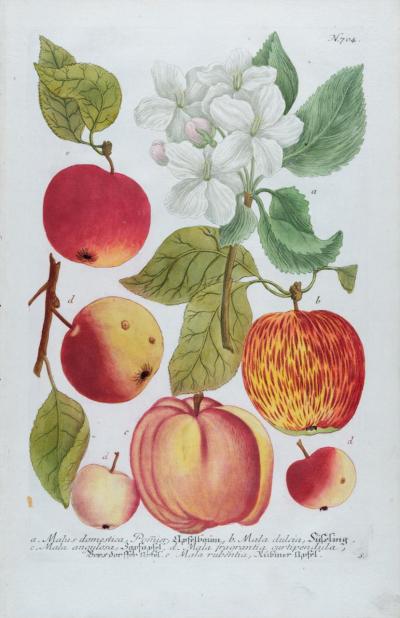Cotton Plant: An 18th Century Hand-colored Botanical Engraving by J. Weinmann
-
Description
This striking hand-colored botanical mezzotint and line engraving is entitled "Gnaphalium, Gossypium (Cotton Plant)". It is plate 551 in Johann Weinmann's monumental publication "Phytanthoza Iconographia", published in Amsterdam in 1738. The print depicts the appearance of several cotton plants, some in bud, others in bloom and some with mature cotton at their tips. Their is also a beautiful depiction of the variety in the appearances of the leaves of cotton plants.
This beautiful hand-colored engraving is printed on laid chain-linked paper measuring 15.25" x 9.75". There are a few scattered small spots, but the print is otherwise in excellent condition.
Johann Wilhelm Weinmann (1683-1741) was a German apothecary and botanist who was greatly respected for his writings on medicinal plants and herbs. He was born in Gardelegen, Germany, the son of a barber named Matthias Christian Weinmann. In 1710, Weinmann settled in Regensburg (also known as Ratisbon) and found work as an assistant to an apothecary. He was able to purchase his own apothecary shop in 1712, and his business acumen allowed him to acquire another apothecary that had gone bankrupt and turn it into a profitable enterprise. He went on to become a successful businessman, serving as a town councillor, commercial assessor, and city assessor.
Weinmann's most significant contribution to the field of botany in the 18th century was his creation of the botanical work "Phytanthoza iconographia" between 1737 and 1745, an ambitious eight-volume project featuring over 1,000 hand-colored engravings of over 4,000 plant species. The work is highly regarded for its comprehensive coverage of the plant world and for the quality and accuracy of its illustrations. It is considered the first important botanical work to use color engraved prints. Weinmann employed the renowned botanical illustrator Georg Dionysius Ehret to contribute drawings to the project. a well respected botanist and entomologist and one of the most influential European botanical artists of all time. Weinmann was greatly respected for his writings on medicinal plants and herbs, and "Phytanthoza iconographia" is recognized as a landmark botanical work, one of the most comprehensive botanical references of the eighteenth century. It has been described as a pioneering work of botanical prints and it remains today one of the most ambitious works ever undertaken. In addition to "Phytanthoza iconographia", Weinmann also published a work called "Catalogus Alphabetico ordine exhibens Pharmaca" in 1723, and contributed botanical notes as "Observationes und Anmerkungen" in the "Breslauer Sammlungen". -
More Information
Documentation: Documented elsewhere (similar item) Period: 18th Century Condition: Good. Styles / Movements: Traditional Incollect Reference #: 713101 -
Dimensions
W. 9.75 in; H. 15.25 in; W. 24.77 cm; H. 38.74 cm;
Message from Seller:
Timeless Intaglio is an online gallery of rare and collectable antiquarian prints, maps and books. Although we specialize in all forms of vintage printed works on paper, the majority were created with the intaglio method of transferring ink from a plate, usually copper, to paper with a technique utilizing pressure generated by a press. Email us directly: rbreiman@timelessintaglio.com

















